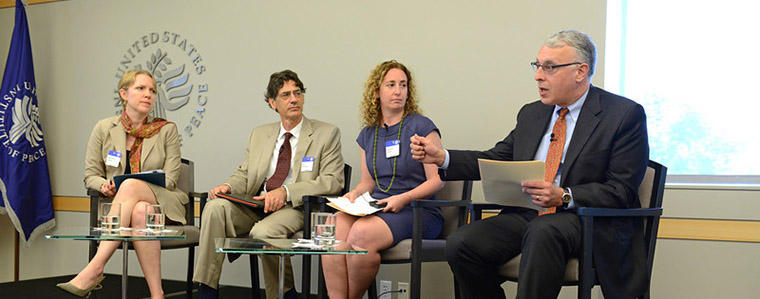In efforts to steer young people away from violence, context is everything. Whether it's understanding how a program for selected youths in Sierra Leone could backfire or digging deep for the reasons young Palestinian men turn to violence, effective interventions require rigorous research and attention to local conditions.

With young people making up the primary participants in violence, a recent panel of U.S. government officials and other experts organized with Mercy Corps at USIP explored the reasons for the phenomenon and the effectiveness of U.S. policy towards vulnerable youth populations.
"Responding to these trends and figuring out how to be effective in countering them is an urgent concern," said Steve Heydemann, USIP's vice president for the Center for Applied Research on Conflict.
Marc Sommers, a consultant and visiting researcher at Boston University's African Studies Center, told the story of the unintentional effect of a U.S. program that relied on community elites to recommend young people to participate. The result was that the participants were those being rewarded for their loyalty to local authority figures, discrediting the program in the eyes of others. Young women with children were particularly upset that they weren't represented among the "favored youth." Such exclusion can have serious consequences, however unintentional.
"Certain desires seem universal – young men and women everywhere want to be safe, educated and respected," said Anne Richard, U.S. assistant secretary of state for population, refugees and migration. "They want a fair shot at the future."
Rite of Passage
The majority of vulnerable youth in conflict zones who might be susceptible to violence are victims of circumstance, Richard said. Sommers explained that, in conflict zones, young men might participate in violence as a way to gain recognition, and in turn, be considered an adult. In Palestine during the First Intifada, for example, research found that taking part in violent resistance was seen as a rite of passage to manhood, and the youths were welcomed back into their communities as heroes, Sommers said.
The type of group that a young person joins is more a result of proximity, opportunity and familiarity than an indication of a particular political ideology, said Maryanne Yerkes, a senior civil society and youth advisor at the U.S. Agency for International Development. She cited a report on youth violence by the Organization for Economic Cooperation and Development.
Yerkes argued for a greater focus on community resiliency -- a community's ability to bounce back after conflict. Many youth turn to violence because they lack confidence in the prospects for their community and local government, Yerkes said.
Youth-targeted programming should aim to create connections with local government to address frustration. By working with local leaders, such as in the case of USAID-funded projects in Kenya, programming can be sustained by the community in the long run, and youth see local government as a partner, rather than opponent.
Conflicting Findings
Rebecca Wolfe, director for conflict management and peacebuilding at Mercy Corps, underscored the importance of research, citing case studies from Kenya, Afghanistan and Somalia.
"We began to delve deeper into this question of the drivers of youth violence in response to the conflicting results in the literature about why young people participated" in violence, Wolfe said.
In particular, they found that programs focused heavily on creating and identifying jobs for young people even where there was little evidence that such interventions increase stability. Programming should be designed with the explicit goal of stability; increasing employment assists in development, but not necessarily stability, she explained.
"Increasing employment alone will not directly nor quickly impact stability," Wolfe said. "This does not mean development interventions are not important in their own right. But they may not directly impact stability in every case."
Programs also should be constantly evaluated, the panelists said.
"As violence shifts in society, so should our prevention approaches," said Wolfe.
While research and programs focus almost entirely on youth who commit violence or are susceptible, the other side of the coin gets scant attention – the fact that the vast majority of youth manage to resist violence and reject its use. Sommers encouraged more research on that phenomenon as a way of understanding the reverse.
"Why are youth peaceful?" Sommers asked. "Most youth are remarkably peaceful given their circumstances."
Aparna Ramanan is a senior program assistant in USIP's Center for Applied Research on Conflict.